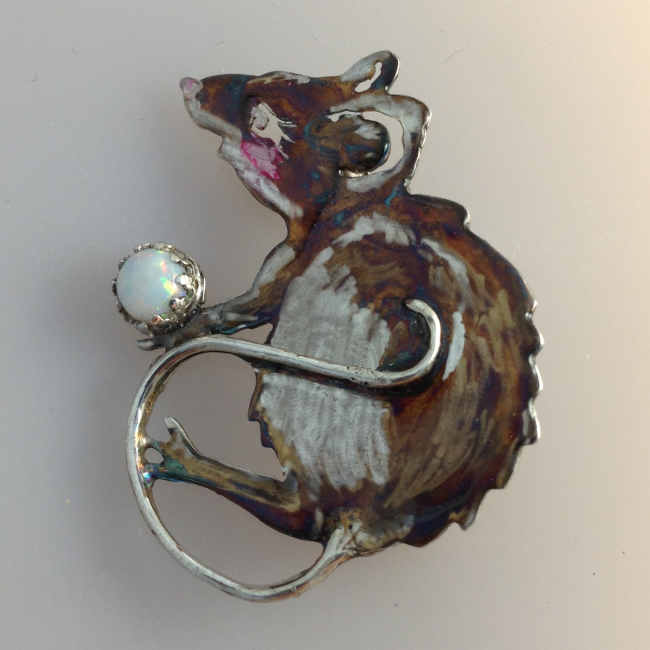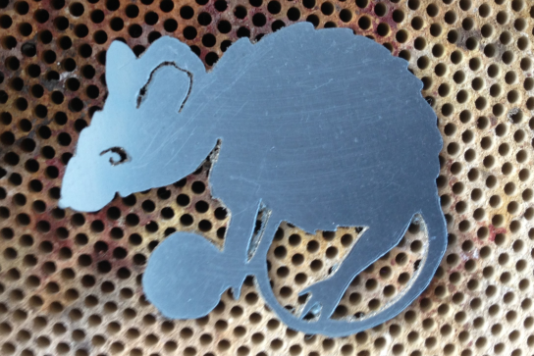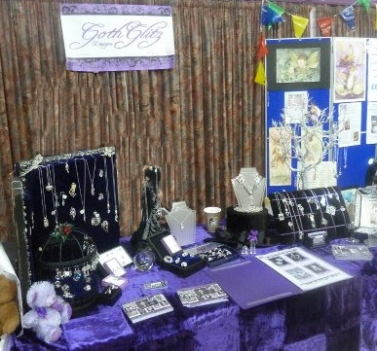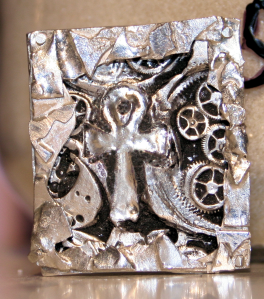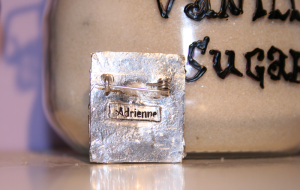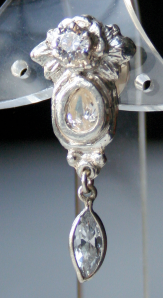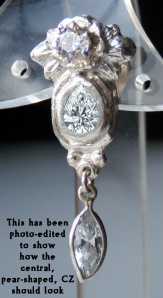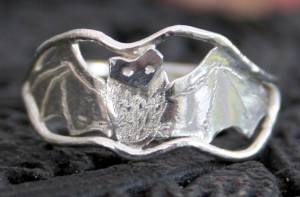I’m going to be at a craft fair on 5th September 2013 (, which is also a book launch for the next installment of Tales from Beauty Bank. They are stories about a wonderful family of mice and their exciting adventures in and around the English county of Cheshire.
Well, when I heard that there was to be a new book, I so wanted to make a jewellery version of one of the little mice. I contacted the author, Michael R. Beddard for his permission, and after checking with the artist, Rebecca Yoxall, I got the go ahead and this is what happened.
I was sent an image of Carlos, a mouse not yet seen in the books, for reference. He looked so sweet and I decided that he’d make a wonderful brooch. There had been clues about gems being of some importance in the new story, so I decided to make him holding a sparkling gem in his little paws.
I decided to draw his outline on paper and looked to see if there would be any weaknesses in the design. To help strengthen the finished piece, I gave him a curl to his tail and took it up and over his body. To give an extra dimension to the mouse, his tail would be added on in round wire, but to give strength, I would also cut out it’s shape in the silver sheet.
Above, you can see the silver sheet pierced (using a Knew Concepts hand saw, which is an amazing piece of kit) and with it’s protective film still on. I’ve left the area for the gem quite large for the moment, just in case I change my mind about the gem or the exact placement.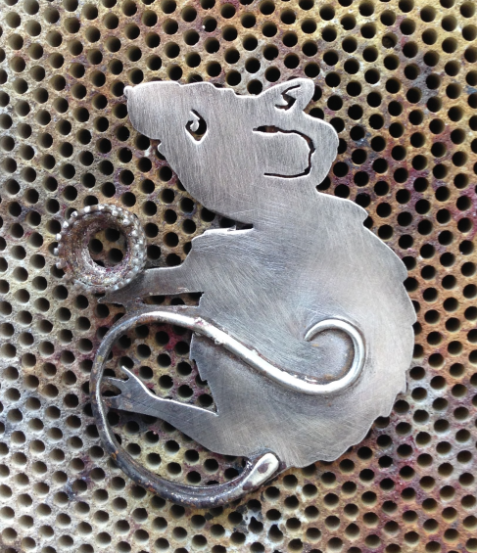
This is Carlos with his tail and bezel soldered on. He’s had a first filing to smooth any rough edges and to check all the surfaces are joined well. He’ll go in the pickle after I solder the brooch pin on the back. His tail was slightly flattened at one end and the tip was filed to taper down to a blunt point. As I was using round wire (1mm diameter), I filed the base down slightly to give a flat edge which would connect well with the main body and give a good connection when soldered.
Just a note on the brooch pin itself. If it gets heated then it will loose it’s hardness and become annealed (soft for working with). Also, air-cooling rather than quenching in water will help too. I work-harden it back to usability by hitting it with my rawhide hammer until it becomes strong enough not to bend easily.
The bezel is made from fancy bezel wire (it just means shaped and not plain strip) which has been soldered into a circle (5mm inside diameter) and a jump ring has been slightly flattened and soldered inside as the bezel shelf. I checked the gem in the mount, and as the gem was faceted, I filed the seat of the bezel to fit.
On the main body of the piece, I worked out where exactly the bezel would sit, and took out a circle of about 3mm across for both reasons of weight and ease of keeping the stone clean. The bezel was then sweat-soldered (solder was melted onto one surface only and then gently re-melted with the bezel sitting on top) to the piece.
After pickling, filing and polishing, It was time to give this little boy some colour. I decided to use Liver of Sulphur with a brush and try to re-create the feel of the original watercolour. I layered on the liquid LoS and then washed it off in cold water (it stops the chemical reaction, but unfortunately not the rotten egg smell). I did this quite a few times, as the colours changed from gold to brown to blue and then purple. I used a fine silicon polishing stick in my Dremel to rub away the patina to give lovely highlights and show off his lovely white tummy. And here he is …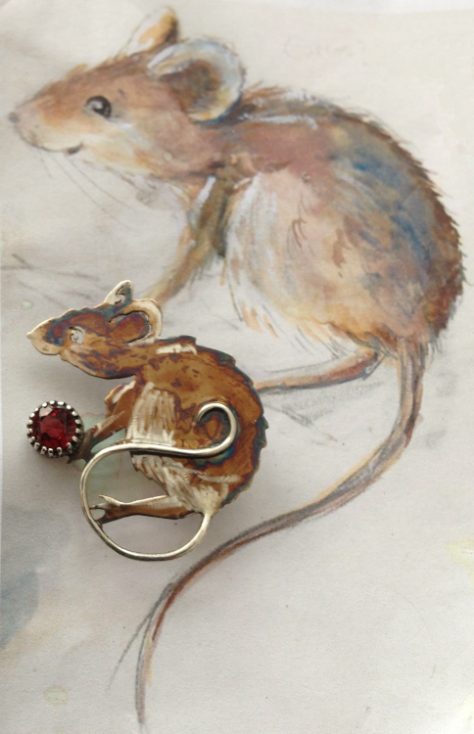
The gem is real garnet and I think he looks splendid with it!
Well, I thought I was finished but I sat thinking about how to protect the finish. Normally, I would use Renaissance Wax but I was really worried about the patina scratching, even through the wax, This time I decided to seal the colour with a glossy doming resin that is cured by UV rays. I use a toothpick to drop the resin onto the piece, starting round the edges and curing that before going on to fill in the center (this is because the resin has a tendency to pull in, leaving the edges exposed).
Here is little Carlos with his new protective coat:
UPDATE:
The author liked my version of Carlos so much, he commissioned me to make a similar one for his mum. She loves opals and so I sourced a special translucent opal (solid, not a doublet or triplet) with beautiful flashes of colour. I decided that this mouse would be Rachel, who is in the books!
The differences are the eyelashes and her more finely shaped head. She has a pink nose and pink cheeks, which were done using watercolour & gouache paint after the LoS patina was applied. The first photo below is before the resin top coat and the second one, after the top coat was applied.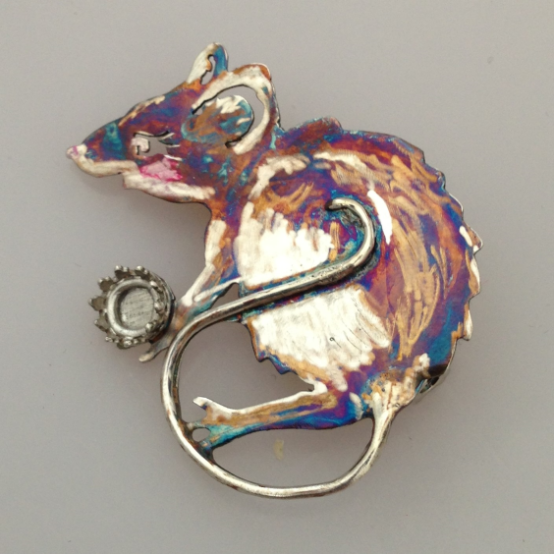 T
T
I can’t wait to see how these two little mice are received at their own little coming out party to celebrate the book launch. I hope Michael’s mum and whoever has Carlos, will love them as much as I do.